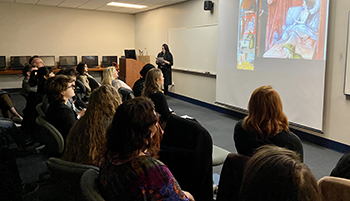Leda and Mary:Two Women, Two Worlds, One Story
Description/Abstract/Artist Statement
Leda and the Swan was a very popular subject amongst Italian Renaissance artists, including Antonio Allegri da Correggio and Leonardo da Vinci. The pagan story and the paintings associated with it have long been looked at as a response to a passage in Ovid’s Metamorphoses. Some scholars have shined a negative light on these sumptuous images, relating them and the pagan story to rape, even though the images by both Correggio and Leonardo do not exude fear. Instead, both artists evoke a welcoming and loving spirit within their paintings. Scholars have not considered the historical context of these images, and the fact that many artists, humanists and clerics were looking at pagan images and stories through a Christian lens. As a result of this neglect in context, rape has been at the forefront of many scholarly interpretations. This paper argues that the renditions of the story of Leda and the Swan, created by Correggio and Leonardo, were not showing a story of rape, but rather an allusion to the exemplary nature of the women as paralleled with the Virgin Mary and their roles as mothers of children who shaped both the pagan and Christian worlds.
Faculty Advisor/Mentor
Anne Muraoka
Presentation Type
Oral Presentation
Disciplines
Ancient, Medieval, Renaissance and Baroque Art and Architecture | Comparative Methodologies and Theories
Session Title
College of Arts & Letters 5
Location
Learning Commons @ Perry Library Room 1306
Start Date
2-8-2020 11:30 AM
End Date
2-8-2020 12:30 PM
Leda and Mary:Two Women, Two Worlds, One Story
Learning Commons @ Perry Library Room 1306
Leda and the Swan was a very popular subject amongst Italian Renaissance artists, including Antonio Allegri da Correggio and Leonardo da Vinci. The pagan story and the paintings associated with it have long been looked at as a response to a passage in Ovid’s Metamorphoses. Some scholars have shined a negative light on these sumptuous images, relating them and the pagan story to rape, even though the images by both Correggio and Leonardo do not exude fear. Instead, both artists evoke a welcoming and loving spirit within their paintings. Scholars have not considered the historical context of these images, and the fact that many artists, humanists and clerics were looking at pagan images and stories through a Christian lens. As a result of this neglect in context, rape has been at the forefront of many scholarly interpretations. This paper argues that the renditions of the story of Leda and the Swan, created by Correggio and Leonardo, were not showing a story of rape, but rather an allusion to the exemplary nature of the women as paralleled with the Virgin Mary and their roles as mothers of children who shaped both the pagan and Christian worlds.


